初中英语语法总结(动词不定式)
- 格式:doc
- 大小:158.50 KB
- 文档页数:52
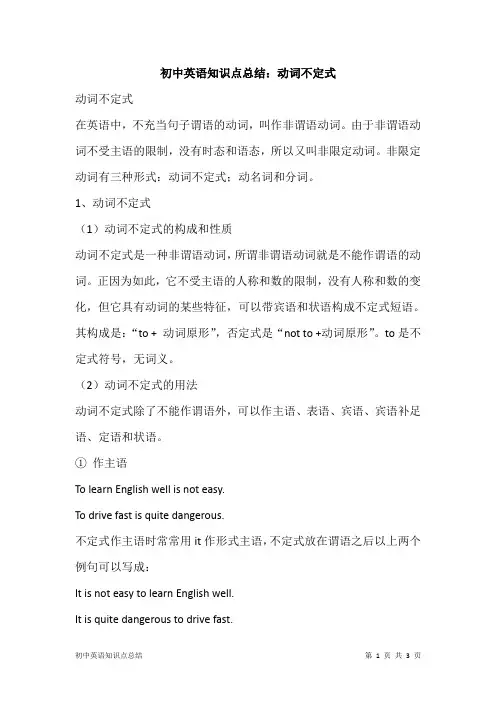
初中英语知识点总结:动词不定式动词不定式在英语中,不充当句子谓语的动词,叫作非谓语动词。
由于非谓语动词不受主语的限制,没有时态和语态,所以又叫非限定动词。
非限定动词有三种形式:动词不定式;动名词和分词。
1、动词不定式(1)动词不定式的构成和性质动词不定式是一种非谓语动词,所谓非谓语动词就是不能作谓语的动词。
正因为如此,它不受主语的人称和数的限制,没有人称和数的变化,但它具有动词的某些特征,可以带宾语和状语构成不定式短语。
其构成是:“to + 动词原形”,否定式是“not to +动词原形”。
to是不定式符号,无词义。
(2)动词不定式的用法动词不定式除了不能作谓语外,可以作主语、表语、宾语、宾语补足语、定语和状语。
①作主语To learn English well is not easy.To drive fast is quite dangerous.不定式作主语时常常用it作形式主语,不定式放在谓语之后以上两个例句可以写成:It is not easy to learn English well.It is quite dangerous to drive fast.这种用法可以归纳成这样一个句型:It is (not) + 形容词+ (for sb.) to do sth.It is very expensive for me to buy a car.It is very difficult for a child to do that job.有些形容词之后跟of + 名词(代词宾语)+不定式。
如:It is very kind of you to say so. It is very good of you to come.②作表语。
如:My job is to teach English. The first thing is to ring him up.③作宾语。
如:She wanted to ask you a question. He forgot to turn off the light. We decided to hold a class meeting.常见的可以用不定式作宾语的动词有:like, love, begin, start, try, ask, prefer, hate, find等,有些形容词可接不定式,这种不定式也可作宾语。
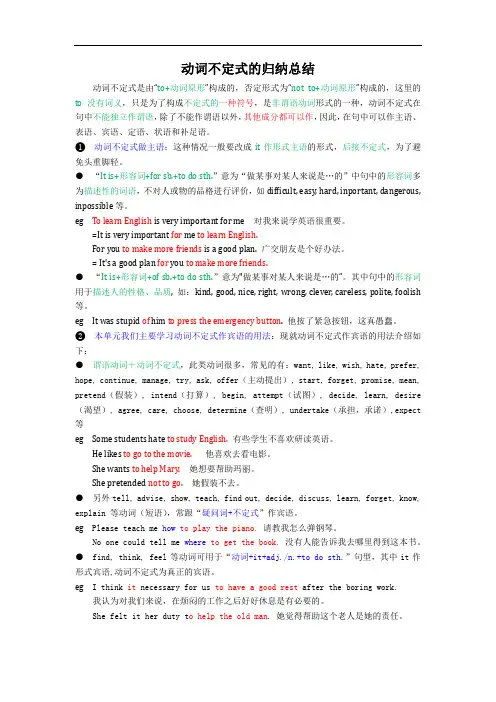
动词不定式的归纳总结动词不定式是由“to+动词原形”构成的,否定形式为“not to+动词原形”构成的,这里的to没有词义,只是为了构成不定式的一种符号,是非谓语动词形式的一种,动词不定式在句中不能独立作谓语,除了不能作谓语以外,其他成分都可以作,因此,在句中可以作主语、表语、宾语、定语、状语和补足语。
❶ 动词不定式做主语:这种情况一般要改成it作形式主语的形式,后接不定式,为了避免头重脚轻。
●“It is+形容词+for sb.+to do sth.”意为“做某事对某人来说是…的”中句中的形容词多为描述性的词语,不对人或物的品格进行评价,如difficult, easy, hard, inportant, dangerous, inpossible等。
eg To learn English is very important for me 对我来说学英语很重要。
=It is very important for me to learn English.For you to make more friends is a good plan. 广交朋友是个好办法。
= It's a good plan for you to make more friends.●“It is+形容词+of sb.+to do sth.”意为"做某事对某人来说是…的”。
其中句中的形容词用于描述人的性格、品质, 如:kind, good, nice, right, wrong, clever, careless, polite, foolish 等。
eg It was stupid of him to press the emergency button. 他按了紧急按钮,这真愚蠢。
❷ 本单元我们主要学习动词不定式作宾语的用法:现就动词不定式作宾语的用法介绍如下:●谓语动词+动词不定式,此类动词很多,常见的有:want, like, wish, hate, prefer, hope, continue, manage, try, ask, offer(主动提出), start, forget, promise, mean, pretend(假装), intend(打算), begin, attempt(试图), decide, learn, desire (渴望), agree, care, choose, determine(查明), undertake(承担,承诺),expect 等eg Some students hate to study English. 有些学生不喜欢研读英语。
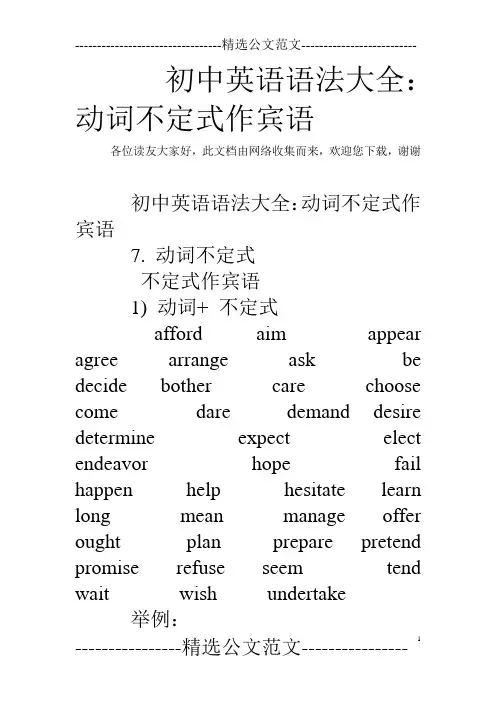
初中英语语法大全:动词不定式作宾语各位读友大家好,此文档由网络收集而来,欢迎您下载,谢谢初中英语语法大全:动词不定式作宾语7. 动词不定式不定式作宾语1) 动词+ 不定式afford aim appear agree arrange ask be decide bother care choose come dare demand desire determine expect elect endeavor hope fail happen help hesitate learn long mean manage offer ought plan prepare pretend promise refuse seem tend wait wish undertake举例:The driver failed to see the other car in time.司机没能及时看见另一辆车。
I happen to know the answer to your question.我碰巧知道你那道问题的答案。
2)动词+不定式;动词+宾语+不定式ask, beg, choose, expect , hate, help intend like, love, need prefer, prepare, promise, want, wish…I like to keep everything tidy.我喜欢每件东西都保持整洁。
I like you to keep everything tidy.我喜欢你年使每件东西都保持整洁。
I want to speak to Tom.我想和汤姆谈话。
I want you to speak to Tom.我想让你和汤姆谈话。
3)动词+疑问词+ todecide, know, consider forget, learn, remember, show, understand, see, wonder,hear, find out, explain, tellPlease show us how to do that. 请演示给我们如何去做。

初中阶段动词不定式用法总结1.作主语:- To swim is my favorite sport. 游泳是我最喜欢的运动。
- To learn English well is important for me. 学好英语对我来说很重要。
2.作宾语:- I want to go to the movies. 我想去看电影。
- She loves to read books. 她喜欢读书。
3.作宾补:- My mother asked me to do the chores. 我妈妈叫我做家务。
4.作目的状语:- I studied hard to pass the exam. 我努力学习为了通过考试。
- They went to the supermarket to buy some groceries. 他们去超市买些杂货。
5.作结果状语:- He ran so fast as to win the race. 他跑得非常快以至于赢得了比赛。
- She studied so hard as to get the highest grade. 她学得非常努力以至于获得了最高分。
6.作方式状语:- I go to school by bike. 我骑自行车上学。
7.作定语:- I have a friend to help me. 我有一个朋友来帮助我。
- This is a place to relax. 这是一个放松的地方。
总之,动词不定式在句子中可以作多种语法成分,如主语、宾语、宾补、状语和定语等。
掌握不定式的用法有助于丰富句子的表达方式。

动词不定式知识点一、动词不定式的基本概念。
1. 定义。
- 动词不定式是由“to+动词原形”构成(有时可以省略to),它在句中不能单独作谓语,但具有名词、形容词和副词的特征,可以在句中作主语、宾语、表语、定语、状语和补语等成分。
例如:- To see is to believe.(作主语和表语,“眼见为实”)2. 形式。
- 一般式:to do,表示动作与谓语动词同时发生或发生在谓语动词之后。
例如:I want to go to the park tomorrow.(go这个动作发生在want之后)- 进行式:to be doing,表示动作正在进行,与谓语动词同时发生。
例如:He seems to be reading a book.(read这个动作正在进行,与seem同时)- 完成式:to have done,表示动作发生在谓语动词之前。
例如:I'm sorry to have kept you waiting.(keep you waiting这个动作发生在am sorry之前)- 完成进行式:to have been doing,表示动作从过去一直持续到现在,并且可能还会继续下去。
例如:She is said to have been working on this project for years.二、动词不定式在句中的用法。
1. 作主语。
- 直接作主语时,常用it作形式主语,而将真正的主语(动词不定式)后置。
例如:- It is difficult to learn English well.(真正的主语是to learn English well,it是形式主语)- 但是,当动词不定式作主语的句子中有表语形容词时,也可以直接将动词不定式置于句首。
例如:- To be honest is very important.2. 作宾语。
- 动词不定式可以作某些及物动词的宾语,常见的这类动词有want, hope, wish, decide, manage, expect等。

动词不定式一、动词不定式的基本形式肯定式:to+动词原形否定式:not to+动词原形(to是不定式符号、标志,无意义,可以不翻译。
)二、动词不定式的特征动词不定式是一种非谓语动词形式,它没有人称和数的变化,但有时态和语态的变化,在句子中不能作谓语,但可以作除谓语之外的其它任何句子成分(主语、表语、宾语、宾语补足语、定语和状语);动词不定式具有名词、形容词和副词的特征,同时还保持动词的某些特点,即可以有自己的宾语和状语。
动词不定式和它的宾语和状语构成不定式短语。
三、动词不定式的用法1. 不定式作宾语能跟不定式作宾语的动词(及物动词)很多,构成vt.(及物动词)+to do sth. 结构。
常见的有:want, like, wish, hate, hope, prefer, try, ask, start, begin, decide, learn, choose, agree, expect , remember, forget等。
eg. He wanted to borrow my CD players. 他想借我的CD播放机。
His brother is learning to drive. 他弟弟正在学驾驶。
I hope to speak English well. 我希望讲好英语。
动词不定式作宾语其后又有补足语时,常用it作形式宾语,而把不定式后置。
eg. I find it difficult to learn physics. 我发现学习物理很难。
2. 不定式作宾语补足语动词不定式位于及物动词的宾语后,补充说明宾语,作补足语。
构成vt.+sb.+(not)to do sth. 结构。
常用带to的动词不定式作宾语补足语的动词结构有want sb.to do, ask sb.to do, tell sb.to do, order sb.to do, get sb.to do, wish sb.to do, allow sb.to do, invite sb.to do, teach sb.to do, encourage sb.to do, beg sb.to do等。

初中英语知识点归纳动词的不定式动词的不定式是英语中的重要语法现象之一,学好不定式的用法可以帮助我们更好地理解和运用英语。
本文将对初中英语中动词的不定式进行归纳总结,以便同学们能够更加系统地掌握这一知识点。
一、动词的不定式形式英语中的动词不定式形式为“to + 动词原形”,其中“to”为不定式符号。
不定式的形式通常不受主语的人称和数的限制,一般用作动词、名词、形容词的宾语或补语。
二、不定式作动词的宾语动词不定式可以作为其他动词的宾语,常见的动词有:want, hope, plan, like, love, hate, enjoy等。
例如:1. I want to be a doctor when I grow up.(我长大后想当一名医生。
)2. They like to play basketball in their free time.(他们闲暇时喜欢打篮球。
)三、不定式作名词的补语不定式可以作为某些动词后的名词的补语,常见的动词有:be, become, seem, feel, appear等。
例如:1. Her dream is to become a famous singer.(她的梦想是成为一名著名的歌手。
)2. It seems to be a nice day for a picnic.(今天似乎是个适合野餐的好天气。
)四、不定式作形容词的补语不定式可以作为某些形容词后的补语,常见的形容词有:happy, sad, glad, ready, willing等。
例如:1. He is happy to help others.(他乐意帮助别人。
)2. I am ready to take on the challenge.(我准备好迎接挑战。
)五、不定式作目的状语不定式可以作为目的状语,表示动作的目的或者用途。
常见的动词有:go, come, try, learn, study等。
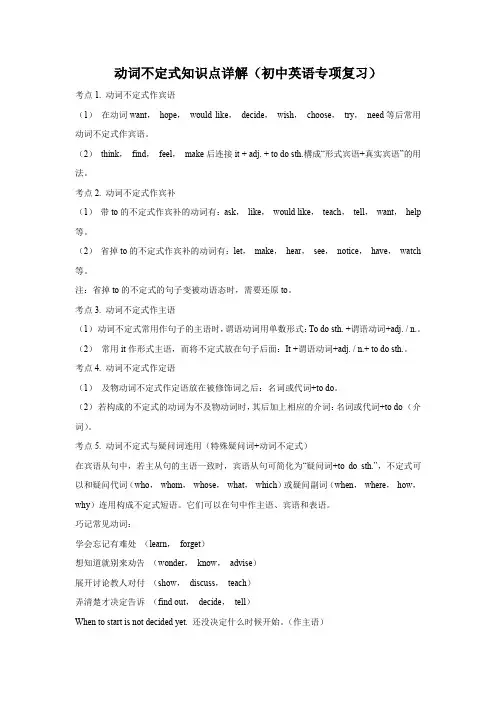
动词不定式知识点详解(初中英语专项复习)考点1. 动词不定式作宾语(1)在动词want,hope,would like,decide,wish,choose,try,need等后常用动词不定式作宾语。
(2)think,find,feel,make后连接it + adj. + to do sth.構成“形式宾语+真实宾语”的用法。
考点2. 动词不定式作宾补(1)带to的不定式作宾补的动词有:ask,like,would like,teach,tell,want,help 等。
(2)省掉to的不定式作宾补的动词有:let,make,hear,see,notice,have,watch 等。
注:省掉to的不定式的句子变被动语态时,需要还原to。
考点3. 动词不定式作主语(1)动词不定式常用作句子的主语时,谓语动词用单数形式:To do sth. +谓语动词+adj. / n.。
(2)常用it作形式主语,而将不定式放在句子后面:It +谓语动词+adj. / n.+ to do sth.。
考点4. 动词不定式作定语(1)及物动词不定式作定语放在被修饰词之后:名词或代词+to do。
(2)若构成的不定式的动词为不及物动词时,其后加上相应的介词:名词或代词+to do (介词)。
考点5. 动词不定式与疑问词连用(特殊疑问词+动词不定式)在宾语从句中,若主从句的主语一致时,宾语从句可简化为“疑问词+to do sth.”,不定式可以和疑问代词(who,whom,whose,what,which)或疑问副词(when,where,how,why)连用构成不定式短语。
它们可以在句中作主语、宾语和表语。
巧记常见动词:学会忘记有难处(learn,forget)想知道就别来劝告(wonder,know,advise)展开讨论教人对付(show,discuss,teach)弄清楚才决定告诉(find out,decide,tell)When to start is not decided yet. 还没决定什么时候开始。
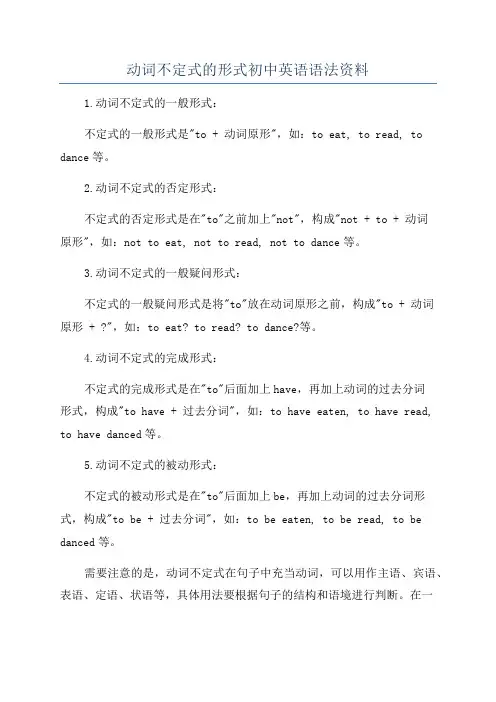
动词不定式的形式初中英语语法资料
1.动词不定式的一般形式:
不定式的一般形式是"to + 动词原形",如:to eat, to read, to dance等。
2.动词不定式的否定形式:
不定式的否定形式是在"to"之前加上"not",构成"not + to + 动词
原形",如:not to eat, not to read, not to dance等。
3.动词不定式的一般疑问形式:
不定式的一般疑问形式是将"to"放在动词原形之前,构成"to + 动词
原形 + ?",如:to eat? to read? to dance?等。
4.动词不定式的完成形式:
不定式的完成形式是在"to"后面加上have,再加上动词的过去分词
形式,构成"to have + 过去分词",如:to have eaten, to have read, to have danced等。
5.动词不定式的被动形式:
不定式的被动形式是在"to"后面加上be,再加上动词的过去分词形式,构成"to be + 过去分词",如:to be eaten, to be read, to be danced等。
需要注意的是,动词不定式在句子中充当动词,可以用作主语、宾语、表语、定语、状语等,具体用法要根据句子的结构和语境进行判断。
在一
些特殊情况下,动词不定式可能省略"to",例如:let me go, make him stop等。

动词不定式的用法总结动词不定式是英语中一种常见的非谓语动词形式,由动词原形加上“to”构成。
它具有多种用法和功能,在句子中可以扮演多种角色。
下面将对动词不定式的用法进行总结和分析。
一、作主语动词不定式可以作为句子的主语,通常位于句首,帮助构成句子的基本结构。
例如:- To learn is to grow. - To study is important for success.二、作宾语动词不定式可以作为动词的宾语,跟在及物动词之后。
例如:- She wants to dance all night. - They decided to go on a trip.三、作介词宾语动词不定式还可以作为介词的宾语,通常介词后面要跟动词的-ing形式,但在某些情况下,使用动词不定式更为恰当。
例如:- She is afraid to speak in public. (介词“in”后接动词不定式) - He is capable of solving difficult problems. (介词“of”后接动词不定式)四、作定语动词不定式可以作为名词的定语,修饰名词。
例如:- I have some books to read. - This is a place to visit.五、作表语动词不定式有时也可以作为句子的表语,描述主语的身份或状态。
例如:- His goal is to become a doctor. - The key is to be patient.六、作宾补动词不定式可以作为宾语的补语,表示对宾语的补充说明。
例如:- She considers him to be her best friend. - They found the task to be challenging.七、作状语动词不定式还可以作为状语,修饰动词或整个句子,表示目的、原因、结果等。
例如:- She works hard to achieve her goals. (目的) - He left early to catch the train. (目的) - He stayed up late to finish his project. (目的) - He left the room, only to return a few moments later. (结果)动词不定式的用法多样灵活,在句子中起着重要的作用。
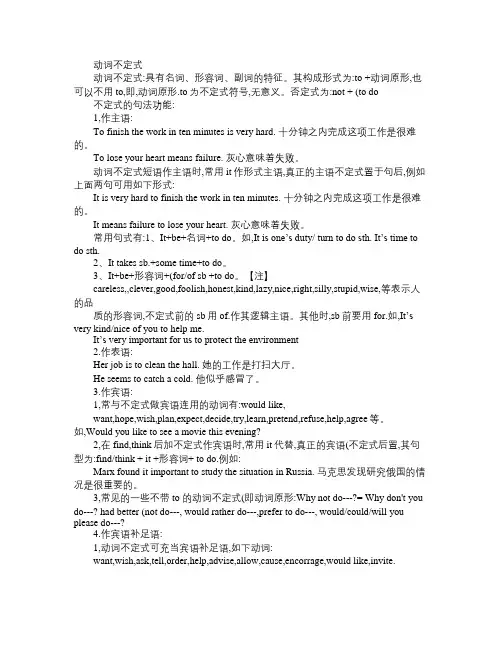
动词不定式动词不定式:具有名词、形容词、副词的特征。
其构成形式为:to +动词原形,也可以不用to,即,动词原形.to为不定式符号,无意义。
否定式为:not + (to do 不定式的句法功能:1,作主语:To finish the work in ten minutes is very hard. 十分钟之内完成这项工作是很难的。
To lose your heart means failure. 灰心意味着失败。
动词不定式短语作主语时,常用it作形式主语,真正的主语不定式置于句后,例如上面两句可用如下形式:It is very hard to finish the work in ten minutes. 十分钟之内完成这项工作是很难的。
It means failure to lose your heart. 灰心意味着失败。
常用句式有:1、It+be+名词+to do。
如,It is one’s duty/ turn to do sth. It’s time to do sth.2、It takes sb.+some time+to do。
3、It+be+形容词+(for/of sb +to do。
【注】careless,,clever,good,foolish,honest,kind,lazy,nice,right,silly,stupid,wise,等表示人的品质的形容词,不定式前的sb用of.作其逻辑主语。
其他时,sb前要用for.如,It’s very kind/nice of you to help me.It’s very important for us to protect the environment2.作表语:Her job is to clean the hall. 她的工作是打扫大厅。
He seems to catch a cold. 他似乎感冒了。
3.作宾语:1,常与不定式做宾语连用的动词有:would like,want,hope,wish,plan,expect,decide,try,learn,pretend,refuse,help,agree等。
初中英语动词不定式用法小结【1 】动词不定式是动词的一种非谓语情势,又叫非谓语动词,它没有人称和数的变更,在句子中不克不及做谓语;它由“to+动词本相”组成,这里的to是动词不定式符号,本身没有词义,其否认情势常在to前加not;因为它仍保持动词的特色,可以有本身的宾语和状语,还可以带疑问词和由for引出其逻辑主语等形成动词不定式短语;不定式或不定式短语具著名词.形容词和副词的特点,在句子中可作主语.表语.宾语.宾语补足语.定语和状语等句子成分.为使同窗们更好地控制其用法,现总结如下:一.动词不定式作主语动词不定式作主语时,为防止句子的头重脚轻,经常应用it作为情势主语,而真正的主语动词不定式后置.如要解释动作的履行者,可在不定式前加for引诱的短语;但假如表语是nice, kind, clever 等描写动作履行者的性情.品德的形容词时,则应在不定式前加of引诱的短语.经常应用句型:It +be+adj./n.+(for/of sb.) to do sth./It takes sb. some time to do sth.二.动词不定式作宾语一些动词,如want, decide, hope, ask, agree, choose, learn, plan, need, teach, prepare,等,常接动词不定式作宾语.当动词不定式作宾语时,假如后接宾语补足语,经常应用it作情势宾语,而把真正的宾语放在宾语补足语之后.应留意有些动词后面可接不定式作宾语,也可接动名词作宾语,但所表达的意义不合.罕有的有:(1)stop to do sth.停滞正在做的事,去做另一件事;stop doing sth. .停滞正在做的事(2)go on to do sth. 做完一件过后,持续做另一件事;go on doing sth.持续做统一件事(3)remember/forget to do sth.记住/忘却去做某事;remember/forget doing sth. 记得/忘却做过某事三.动词不定式作定语动词不定式作后置定语时,与被润饰的名词逻辑上有动宾关系.假如动词不定式是不及物动词时,则要带上与之搭配的介词,组成及物动词短语.动词不定式作后置定语经常应用于“have/has +某事+to do”或“enough+名词+to do”“It’s time to do sth.”等构造中.四.动词不定式作宾语补足语有些动词,如tell, ask, want, invite, teach, like, call等可接带to的动词不定式作宾语补足语,组成tell/ask/want /call/invite sb. to do sth.构造.应留意动词不定式作使役动词和感官动词的宾语补足语时应省去to,在自动语态中应加上to.这些动词可归纳为“一感(feel),二听(listen to, hear),三让(let, make, have,,四看(look at, see, watch, notice),半帮忙(help)(即在动词help后面作宾语补足语时,to无关紧要)”.尚有口诀帮忙记忆:“感使动词真奇异,to在句中像魔鬼,自动句中to分开,自动句中to回来.”(let不必于自动语态)五.动词不定式作状语动词不定式作状语重要用来润饰动词,暗示目标,成果或原因.为了强调目标,有时可以把动词不定式放在句首,或在不定式前加in order或so as.经常应用构造有too + adj./adv. + to dosth.等.六.固定句式中动词不定式的用法在固定句式中对不定式的考核罕有的有:had better (not) do sth./W ould you like to do sth.?/Why not do sth.?/W ould you please (not) do sth.?等.动词不定式专项练习题:一.单项选择.1._______ is difficult to work out the maths problem.2.W e decided _______ at the end of this month.3.They have no paper_______.A.to writeB.to write withC.write onD.to write on4.Let him _______ a rest. I think he must be tired after the long walk.5._______the computer is a problem.A.How to useB.What to useC.Where to useD.Which to use6.The teacher told us _______in bed.A.don’t readB.read notC.to not readD.not to read7.The old man was _______angry _______ say a word.A.so, thatB.as, asC.too, toD.very, to8.Why _______home tomorrow?A.not goB.not goingC.not to goD.didn’t go9.The TV set is too loud. Will you please _______?A.turn down itB.turn it downC.to turn it downD.to turn down it10.It’s cold outside. Y ou had better _______ your coat.A.to put onB. putting onC.puts onD.put on二.用所给动词的准确情势填空.1.It took half an hour _______(get) to the W orldPark from Kitty’s school.2. It was interesting _______(see) so many places of interest from all over the world.3. They want _______(save) time by using shorter words and phrases.4.Kitty’s classmate Daniel taught himself how _______(make) a home page.5.Things _______(do) in Beijing6. He put his photos on it for everyone _______(look) at.7.Help him _______(put) the photos in the correct order.8.He made the girl _______(cry) yesterday.9.It’s time for class. Please stop _______(talk).10. I’d like _______(go) to the Temple of Heaven.参考答案:一.1—5 CCDBA 6—10 DCABD二.1.to get 2.to see 3.to save 4.to make 5.to do。
动词不定式的语法总结动词不定式是非谓语动词的一种形式,是英语中常见的一种语法,学生一定要做好总结,拿下这个知识点。
小编为大家力荐了动词不定式常用的语法总结,给大家作为参考,欢迎阅读!动词不定式的七种用法动词不定式的基本形式为to+动词原形.1.动词不定式做主语.谓语用第三人称单数形式.如果主语较长则用it做形式主语,将真正的主语动词不定式放到句尾.egTo see is to believe.It's a bad habit to run after dinner.2 做表语.the important things is to save lives.3 做宾语he likes to play with children.4做宾语补足语.形容词做宾补时.常用it做形式宾语.把真正的宾语放到宾补之后.he feels it happy to help others.5做定语she asked me to help her with her English.6做状语you are never too old to learn.(结果状语)7特殊疑问词+动词不定式.I am thinking about what to say.动词的不定式的用法口诀①不定式有标记,to与动词连一起。
②没有人称数变化,动词特点它具备。
③主宾定状表补语,唯独作谓不可以。
④not 加上不定式,否定结构要牢记。
⑤疑问词与不定式,构成短语有意义。
⑥仔细推敲多思考,准确判断有依据。
动词不定式专题练习1. This company was the first ____ portable radios as well as cassette tape recorders in the world.A. producingB. to produceC. having producedD. produced2. The purpose of new technology is to make life easier, ____it more difficult.A .not making B. not make C .not to make D. nor to make3. Helen had to shout ______above the sound of the music .A .making herself hear B. to make herself hearC. making herself heard D .to make herself heard4. I don’t know whether you happen_______ ,but I am going to study in the U.S.A this September.A .to be heard. B. to be bearing C .to hear D .to have heard5. The news reporters hurried to the airport, only ______the film stars had left.A .to tellB .to be toldC .tellingD .told6. You were silly not _______your car.A. to lockB. to have lockedC. lockingD. having locked7. The teacher asked us ______so much noise.A .don’t make B. not make C. not making D .not to make8. An army spokesman stressed that all the soldiers had been ordered _____clear warnings before firing any shots.A .to issue B. being issued C. to have issued D. to be issued9. I’d rather have a room of my own, however small it is, than_______ a room with someone else.A. to shareB. to have sharedC. shareD. sharing10. The bank is reported in the local newspaper_________ in broad daylight yesterday.A. robbedB. to have been robbedC. being robbedD. having been robbed11. A number of paintings in the castle are believed ________ina fire.A. being destroyedB. having been destroyedC. to be destroyedD. to have been destroyed12. The meeting _______ next week is sure to be a great success.A. to take placeB. to be taken placeC. to have taken placeD. being taken place13. As a result of my laziness, I failed ________ my work in time.A. and finishedB. to finishC. and finishingD. to finished14. I am sorry ______ written you a letter at the time.A. to have notB. to not haveC. not to haveD. not having15. Will you lend him a magazine _________?A. to be readB. for readingC. to readD. he read16. He could do nothing but _______for the bus _________.A. wait, to comeB. wait; comeC. waiting; comingD. waited; came17 .It is a problem that doesn't need ________ right now.A. to solveB. solvingC. being solvedD. to be solving18. There’s a man at the reception desk who seems very angry and I think he means _______ trouble.A. makingB. to makeC. to have madeD. having made19. I remember _______him _______the bike needed __________.A. hearing, saying, to repairB. to hear, say, to repairC. hearing, say, repairingD. to hear, saying, to be repaired20. --- You should have thanked her before you left.--- I meant _________, but when I was leaving I couldn’t find her anywhere.。
动词不定式知识点详解(初中英语专项复习)考向一动词不定式的结构和句法功能动词不定式的结构动词不定时的构成:不定式的基本形式为:to+动词原形,有时可以不用to,这里的to 是不定式符号,本身无词义,动词不定式的否定形式是not+(to+)动词原形。
肯定式:to + 动词原形It’s nice to meet you.(2)否定式:not to + 动词原形He told me not to leave this room(to是不定式符号,无意义,有时可以不带)动词不定式的句法功能不定式作主语动词不定式作主语时,常用it作形式主语,而将真正的主语放在句末其结构为:①It is +adj.+for/of sb.+(not)to do sth.意为"做某事对某人来说是……"。
①It takes sb.+some time+to do sth.意为"做某事花费某人多长时间"如:To learn English well is useful.→ It is useful to learn English well.It’s important for us to protect the environment.注意:在kind,good,nice,clever等表示人的品质的形容词后,不用for而用of。
如:It's very kind of you to help me. 你帮助我真是太好啦。
不定式作宾语有些谓语动词后只能用不定式作宾语,常见的这类词是表示命令、打算或希望的,如:would like, like, want, wish, hope, decide, plan, expect等。
如:Would you like to see a film this evening? 你今晚想去看电影吗?①在find, think后跟不定式作宾语时,常用it代替,而将真正的宾语放在后面。
如:I find it easy to read English every day.3.不定式作宾语补足语tell, ask, want, allow, warn, advise, invite, get, encourage后常跟动词不定式作宾语补足语。
初中英语不定式知识点归纳随着经济全球化发展,英语在全球范围内被广泛使用,成为国际通用语, 具有国际化。
所以初中的同学们学好英语是很有必要的。
以下是店铺分享给大家的初中英语不定式知识点,希望可以帮到你!初中英语不定式知识点一、用作主语直接把动词不定式置于句首的情况不多,多数情况用it 作形式主语,把真正的主语——动词不定式置于句末,特别是不定式短语较长时。
动词不定式作主语,谓语动词用第三人称单数形式。
带疑问词的不定式短语作主语常置于句首,复合不定式结构作主语常置于句末。
如:1. I t is our duty to try our best to deal with these problems.2.The head teacher said it was necessary to talk with his mother.3.How to learn English well is important.4.To see is to believe.(眼见为实;百闻不如一见)动词不定式作表语,常说明主语的内容、性质、特征。
如:1.The best way is to join an English club.2.The first thing is to listen to the teacher carefully.三、用作宾语1. 可以接带to 的动词不定式作宾语的动词主要有:要求选择同意(ask, choose, agree),期望决定学习(expect, hope, decide, learn) ,宁可假装知道(prefer, pretend, know) ,希望想要愿意(wish, want, would like / love)。
如:1)We decided to talk to some students about why they go there.2)He prefers to eat white bread and rice.3)Id love to visit Mexico.2. 动词decide, know, learn, show, teach, tell...,介词结构on...可用疑问词带to 的不定式短语作宾语,但why 后面的不定式不带to 。
动词不定式的用法总结动词不定式(to do)是初中英语课的一个重点,也是中考要考查的一个项目。
接下来,小编给大家准备了动词不定式的用法总结,欢迎大家参考与借鉴。
动词不定式的用法总结动词不定式属于非谓语动词的一种形式,很多同学经常把它和谓语动词混在一起,掌握起来有困难。
下面我们对动词不定式的用法做简单归纳,帮助同学们记忆:一、动词不定式在句子中不能充当谓语,没有人称和数的变化。
二、动词不定式是由“to+动词原形”构成(有时可以不带to)。
动词不定式的否定形式是“not+动词不定式”(not不与助动词连用)。
三、动词不定式短语具有名词、形容词和副词等的功能,可在句中用做多种句子成分。
1、主语:常置于句末,而用it代替其做形式主语。
例:To go in for sports helps youstay fit.(book4,L28)It helps you stay fit to go in for sports. It is dangerous to swim in the deep sea on your own.注:此句式中不定式逻辑上的主语可由for或of引出,逻辑主语由of引出时,表语的形容词为kind,nice,good,polite,clever,foolish,right,wrong等表示评价的形容词。
例:It's right of him to refuse the invitation1.(him为逻辑主语)2、表语:Our duty is to protect the enviroment.3、动词宾语:此种情况可按固定搭配或句式去记。
例:would you like to see my photos?Kevin planned to visit his uncle.(book4,L11)和plan用法一样的词还有:start,want,agree,hope,begin,decide等。
初中英语语法总结(动词不定式)★清华大学★英语系测试:为中学英语量身定做.官方网站:/清华大学英语教授50年研究成果初中英语语法(动词不定式)1.不定式的基本形式与结构动词不定式指通常由to加上动词原形(如to write) 所构成的一种非限定性动词形式,但在有些情况下to可以省略。
动词不定式有进行体和完成体(如上to be writing,to have written),也有被动态(如to be written),所有的主动词,不论是及物动词还是不及物动词,也不论是动作动词还是状态动词,都有不定式形式。
助动词除be和have外,没有不定式形式。
动词不定式在语法功能上可作主语、宾语、表语、定语和状语。
2.不定式的用法1)不定式结构作主语1.Te get contact with his family in Taiwan made him extremely happy since they separated more than 40 years ago.2.To finish that task in such a short time is really a challenge.在上述情况下,如果不定式较长,显得头重脚轻,则可由代词让作形式主语(形式主语it不可由that或this等其他代词代替),而将不定式放到后面。
如:1.It made him extremely happy to get contact with his family in Taiwan since they separated more than 40 years ago.2.John admitted that it is always difficult for him to be on time.不定式结构所表示的动作是谁做的,即不定式的逻辑主语,通常可以通过for sb. to do sth. 结构表达:1.It is quite important for us to read good books during a general review.2.It is not difficult fot those talented students to pass the exam.在某些形容词(如careless,clever,considerate,foolish,good,impolite,kind,naughty,nice,silly,stupid等)作表语时,不定式后可以加of来引导出其逻辑主语:1.It is very kind of you to tell me the truth.2.It is stupid of him to do such a silly thing.2)不定式作宾语不定式作宾语有两种:一种是及物动词后直接跟带to的不定式,另一种是“及物动词+疑问词+带to的不定式。
及物动词+带to的不定式结构:只能跟动词不定式的动词,常见的有: afford,agree,aim,appear,ask,believe,care,claim,decide demand,desire,determine,expect,fail,happen,hesitate,hope,intend,learn,long,manage,offer,pretend,promise,prepare,refuse,seek,swear,undertake,want,wish等。
1.He managed to solve the complicated problem.2.The stranger offered to show me the way.3.Mr. Smith undertook to build a new plant in South Africa.动词+疑问代(副)词+不定式:这类动词常见的有advise,decide,find out,forget,inquire,know,learn,see,regard初中英语语法总结,remember,teach,tell,understand,wonder等。
常见的疑问代(副)词有: what,when,where,which,how,whether等。
1.He does not know when to start.2.Y ou can decide whether to continue or to stop.3.I will show you how to deal with it.有时,不定式可由it代替,而把不定式放到后面去。
这可以用这一结构表达:动词(如find,think,consider,feel等)+it+ 形容词+不定式。
1.She considers it necessary to make friends with him.2.We find it difficult to finish all the homework before 9 o’clock.3)不定式做表语一种情况为主语是不定式(表示条件);表语也是不定式(表示结果):1.To see is to believe.2.To work means to earn a living.另一种情况为主语是以aim,duty,hope,idea,job,plan,problem,purpose,thing,wish等名词为中心的短语,或以what 引导的名词性从句,不定式表语对主语起补充说明作用:;例如:1.His aim is to study abroad in the near future.2.The most important thing is to negotiate with them about the price.3.What I want to say is to forget all the unhappy experience.4)不定式作定语不定式结构作名词词组修饰语主要有三种类型:第一种,被修饰的名词词组是不定式的逻辑宾语。
例如:1.There was really nothing to fear.2.He gave me an interesting book to read.如果不定式是不及物动词,后面就得加相应的介词。
例如:1.Mary needs a friend to play with.2.That girl has nothing to worry about.3.They have a strict teacher to listen to.4.Although the film had been on for ten minutes,I still was not able to find a chair to sit on.第二种,被修饰的名词词组是不定式的逻辑主语;例如:1.Have you got a key to unlock the door?2.The action to be taken is correct.3.There is nothing to be gained by pretending.第三种,被修饰的名词词组是不定式的同位结构。
这类名词通常是表示企图、努力、倾向、目的、愿望、is算、能力、意向等意义的名词:ability,attempt,effort,impulse,inclination,wish等。
例如:1.Her daughter will make an even bigger effort to please her.2.I have no wishto quarrel withyou.3.Neither of them had any inclination to do business with Mary.5)不定式作状语不定式结构在句中作状语通常都能转换为限制性状语从句。
例如作原因状语:1.They are quite surprised to see the great changes taking place in the area.2.They are quite surprised because they see the great changes taking place in the area.3.He was lucky to arrive before dark.4.He was lucky because he arrived before dark.作目的状语:1.She raised her voice to be heared better.2.She raised her voice so that she could heard better.3.We went via Heidelberg to miss the traffic jam.4.We went via Heidelberg so that we could miss the traffic jam.作结果状语:1.The French football team played so successfully as to defeat the Brazilians.2.The French football team played so successfully that they evendefeated the Brazilians.3.He got to the station only to be told the train had gone.4.He got to the station and was told that the train had gone.不带to的不定式的使用动词不定式通常带to,但在有些搭配中不带to,在另一些搭配中可带to可不带to。
归纳起来,以下情况下使用不带to不定式:1) 在can/could,/may/might,will/would,shall/should,must,need,dare等情态动词之后,动词不定式不带to。
2)在表示感觉意义的动词,如see初中英语语法总结,feel,watch,notice,smell,hear,observe等后,或是表示“致使”意义的动词,如have,let,make等后,动词不定式不带to。
例如:1.I often heard him say that he would study hard.2.I must have him see his own mistakes.但是,当这类结构转换为被动语态时,后面的不带to不定式一般转换为带to不定式。